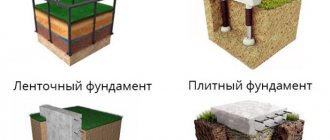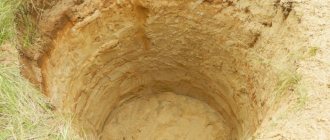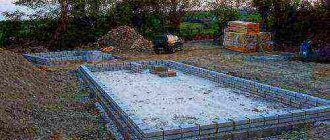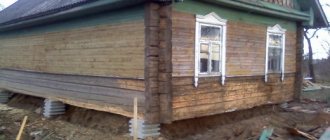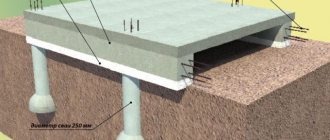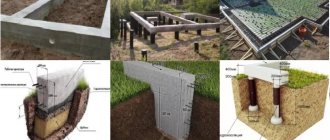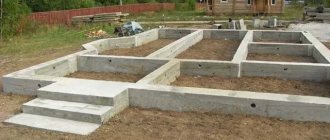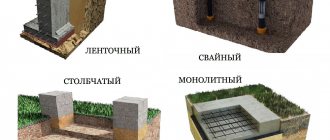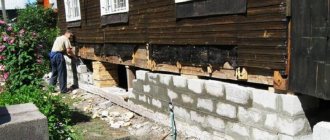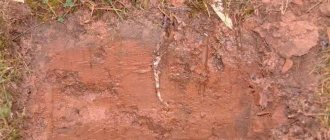The foundation is the basis of any building. The stronger it is, the longer our building will last. It follows that the better the foundation we want, the more we will have to spend. However, there are times when money for a foundation is short, but it still needs to be built. You also need to choose the best material for building a house.
In this article we will tell you about budget options for foundations that are not inferior in strength and quality to professional ones.
Remember! The choice of foundation depends for the most part not on desire, but primarily on the landscape, type of soil, design features of the building, depth of soil freezing, etc. Based on this data, you need to choose one or another type of foundation.
Today there are 4 most economical types of foundation:
- Columnar.
- Shallow tape.
- Bored.
- On screw piles.
Columnar foundation
The columnar foundation is considered the most budget-friendly, both in terms of money and time, since it is made from ready-made building materials. Built according to all the rules, it can last more than 50 years.
The basis for such a foundation, as the name suggests, are pillars that are driven into the ground at the corners of the future building, where walls intersect, and in other places where there is increased load.
This type of foundation is used to create wooden, frame houses, as well as various outbuildings. Ideal for building baths. However, remember that if you choose a columnar foundation as the foundation of your house, you will not be able to create a cellar or basement.
The following are usually used as pillars:
- Hardwood;
- Red brick (it must be well fired, otherwise it will soon collapse);
- Concrete and rubble stone;
- Monolithic reinforced concrete;
- Reinforced concrete blocks;
- Flagstone;
- Metal pipes.
How to make a reliable foundation and what you need to consider for a new home
- The quality of the soil - how deep it freezes (this is necessary to provide for the so-called swelling of the soil, due to which the building can rise in winter and fall in summer); What type of soil is it - rocky, sandy, clay.
- Groundwater – its presence, depth.
- The structure of the building - how much load it will bear on the foundation.
- Materials from which the house will be built.
- Are there any plans to use basements and basements?
Assessing the soil
Soil assessment can be done by specialists - for this, a well is drilled and the composition of the soil is analyzed. Clay soil swells more in winter than dry soil, so if there are a lot of clay inclusions in the sandy soil, it will swell unevenly and the foundation may be deformed. When laying the foundation, you will need to lay an anti-heaving cushion - simply evenly replace the clay layers with sand.
If you try to evaluate the soil yourself, then, of course, you are unlikely to be able to drill a well. But with careful and careful observation, conclusions can still be drawn.
As soon as the snow melts, in April - early May, pay attention to the number of cracks in the asphalt on the road that leads to the site; if there are many of them, it means that most likely the soil at the site of future construction is heterogeneous. If there are dips in the asphalt, it means that groundwater comes quite close to the surface, so in winter there is a strong compression of the soil
Which house foundation is right for you?
- If your site has silty, heaving soil, the area is being washed away by water: most likely, columnar and strip foundations will not be suitable; A foundation on piles is suitable.
- Dry soil with an even layer of sand: a strip foundation is suitable.
- If you are going to build a large country house, more than 2-3 floors high, or a complex of buildings standing on the same foundation: a pile or slab foundation is suitable.
- Wooden one - two-story cottage without a basement: a columnar foundation is suitable; piles or slabs as a foundation will be a waste of money and materials.
Construction technology
- Laying each foundation begins with marking the territory. You must have a clear plan for the future structure and where the pillars will be located. Often, before starting work, it is necessary to remove up to 30 cm of the top layer of soil.
- Holes are dug at least 1 meter deep. If the holes are not made deep enough, the structure will not be strong and reliable. As for the diameter of the holes, they must be larger than the pillar being buried so that we can fill the remaining space with various fillers in order to strengthen the structure.
- We reinforce the pillars and fill them with mortar. Please note that if you are using ready-made building pillars, there is no need to reinforce and fill with mortar.
- We are building a grillage. A grillage is a kind of concrete platform that evenly distributes the weight of the structure onto the supports. The grillage unites all the pillars into a single whole and thereby eliminates uneven settlement, cracking of walls, corrosion, the formation of dampness, various insects, rodents, etc.
- We're making a pick-up. It is needed to insulate the space under the floor and to prevent snow, debris, moisture, etc. from getting into it. The fence, which is a fencing mesh, is made from any materials, but greater preference is given to brick or stone. The basis for the screed is a concrete screed without a recess, which is laid on a sand cushion.
- After all the work has been completed and concrete has been poured, we begin to erect the floor slabs.
What is their service life?
The service life of a monolithic slab is estimated by experts as very long - some sources estimate it at 100 years. At the same time, contractor companies give a guarantee for the stove for about 15-30 years, which makes one doubt the long service life.
The reasons for this discrepancy may be differences in technology, operating conditions and other factors affecting the material and design. Accurate and confirmed data is not yet available, since the technology appeared relatively recently and statistics have not been collected.
For strip bases, the service time is determined much more specifically . For prefabricated brick belts, 30-50 years are allotted, and for FBS - 50-75 years. Monolithic concrete strips have a design life of up to 150 years.
Shallow belt
A shallow foundation is an excellent alternative to the traditional buried strip foundation, in which the depth is not 1.5-1.8 meters, but only 0.3-0.5. Therefore, such a foundation costs about 40% less than a conventional one and is easier to manufacture.
The main feature of such a foundation is that we replace part of the soil under the base with a sand cushion of the appropriate height, which guarantees us acceptable deformation of the foundation, but nothing more.
Peculiarities:
- You can do without the use of construction equipment;
- Durable enough that you can build small houses, bathhouses or any frame buildings on it;
- Makes it possible to make a basement;
- A wide range of materials and technologies are used in its construction.
Main factors determining choice
Every developer wonders which foundation is best for a house. In order not to make a mistake in your choice, it is advisable to first obtain professional advice from relevant specialists and find out the necessary information:
- the type of soil in a given area and their individual characteristics;
- depth of soil freezing in winter;
- characteristics of the terrain.
The specific features of the selected site for building a house also play an important role.
Area for foundation Source readmehouse.ru
A very important indicator is such a characteristic of the soil as its ability to heave. Very often, the developer does not attach much importance to this indicator, focusing only on his own preferences and material capabilities. Also, the determining factor in this matter is often the opinion of neighbors and historical background. This can lead to dire consequences during the operation of the house.
Construction technology
- After the appropriate markings have been made, we begin to dig trenches approximately 0.7 meters deep. The anti-heaving cushion is 0.3 m, where the lower part (0.2 m) consists of coarse sand, and the upper part (0.1 m) of sand and gravel.
- Next, we compact each of the layers, after which we place a polymer film on the base of the trench, which will prevent the cement from leaking into the sand cushion.
- After we have installed the formwork, we attach roofing felt to it. Thanks to roofing felt, we will prevent concrete mortar from leaking out through the cracks between the boards, and after completion of construction work, it will be much easier to dismantle the formwork.
- We knit a frame from reinforcement and then pour concrete into the trenches.
- In two weeks we begin to erect the walls.
Which type is built faster?
When pouring a concrete strip or slab, you have to let the concrete sit for a certain amount of time. This greatly slows down construction, but in this case it is impossible to speed it up . When creating a prefabricated strip or laying ready-made reinforced concrete slabs, construction time is significantly reduced.
In addition, pouring concrete is possible only in the warm season, which significantly limits the possibilities of creating monolithic slabs or strips, while prefabricated structures, with some restrictions, can be built at any time of the year.
Therefore, the speed does not depend on the type of base, but on its design.
Bored foundation
The bored foundation is of the pile type. It is also considered one of the most economical and reliable.
Bored piles are made directly in the ground.
- Wells are drilled at pre-marked locations, into which metal reinforcement cages are installed, and then the solution is poured into them.
- If the soil is loose, then to protect the walls of the well from destruction, use a lining made of roofing felt.
- Next, a grillage is installed, thanks to which the underground part of the foundation is tied together and an even distribution of weight is ensured.
The big advantage of a bored foundation is its ability to withstand not only light wooden or frame houses, but also the load of heavy stone houses, without settling.
Which one is better?
It is incorrect to talk about which foundation is better. Each type is designed to perform specific functions in appropriate conditions, so choosing one option over another can only be done when considering specific hydrogeological and other factors.
It is impossible to state unambiguously about the advantage of any type of support structure without reference to the situation. The slab floats freely on unstable soils, unsuitable for belt construction. At the same time, a strip foundation, built in suitable conditions, is much cheaper and more economical than a slab.
Foundation on screw piles
A pile foundation is also considered beneficial due to the fact that the volume of excavation work is reduced, hence saving both time and labor costs. In addition, it is 40% cheaper than conventional tape or monolithic. When building a pile foundation, you can do without heavy equipment.
The material for screw piles is steel pipes. At the bottom of the pile there is a cutting blade of different shapes, which can effortlessly enter the soil to the required depth.
Peculiarities:
- Such a foundation can be erected at any time of the year;
- Has a high load-bearing capacity;
- Possibility of building a foundation in 1-2 days;
- Can be used even on difficult terrain.
Advantages and disadvantages of each framework (conclusions)
In addition to the characteristics of the foundation, the characteristics of the site should be taken into account. It is to this that you will first have to adapt. Let's summarize the information about each type of foundation.
Slab base
Advantages:
- long service life;
- Suitable for laying on most soils;
- foundation installation work takes little time;
- the base is one of the most durable due to the uniform distribution of the load.
Flaws:
- not suitable for temporary buildings;
- It is problematic to fill such a foundation alone;
- the most expensive type of foundation.
Tape base
Advantages:
- a house is built on it from almost any material (brick, blocks, wood, etc.) and a strip base of any configuration;
- you can build it yourself;
- material consumption is minimal;
- option is suitable for most soil types;
- you can change the width and depth of the foundation.
Flaws:
- If the building is too massive, the foundation may not be able to support it;
- it is impossible to construct a strip base in places with a significant difference in height;
- the strength of the structure decreases due to severe frosts and heat.
Construction technology
- Manually or mechanically, at previously marked places, screw piles are screwed into the ground to a certain depth.
- After installing them, using a rangefinder, mark the height and, using a grinder, cut the piles to the established level.
- Then sand concrete is poured inside each pile.
- Next, a special steel plate (head) is installed on each pile, which serves to distribute the load over the entire cross-sectional area.
- Then the piles are tied with a grillage, which will give the structure the greatest strength.
- After completing the foundation work, we proceed to the next stage of construction.

